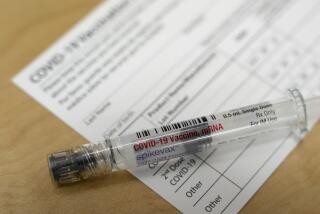Flu shot isn’t for H1N1
- Share via
With the so-called swine flu continuing to spread across the United States and the world, the Food and Drug Administration announced recently that it has given the go-ahead for the final preparation and distribution of a vaccine for the coming flu season.
But that vaccine will not protect against swine flu, more officially known as the novel influenza A (H1N1) virus. That virus has sickened almost 45,000 and killed more than 300 in the United States since the spring. Those numbers are only confirmed cases, however; the true number of people affected is much higher.
“The FDA continues to work with manufacturers, international partners and other government agencies to facilitate the availability of a safe and effective vaccine against the 2009 H1N1 virus,” said the FDA announcement.
Six vaccine manufacturers will be producing the 2009-2010 influenza vaccine. And the vaccines will contain the strains of three viruses -- one of them an “H1N1-like” virus identified as A/Brisbane/59/2007. The strain in the seasonal flu preparation is not the same as the so-called swine flu, however and, therefore, is not expected to carry any protection against it.
So where the heck is that swine flu vaccine? And, in the meantime, why would you go to the trouble to get yourself vaccinated against a flu vaccine that doesn’t protect you from the dreaded swine flu?
In meetings with state and local officials earlier this month, Health and Human Services Secretary Kathleen Sebelius said she expects a new swine flu vaccine to be available for distribution by mid-October -- fully six to seven weeks after American schoolchildren will have flocked back to the germ pools of their classrooms. Sebelius hasn’t formally approved a nationwide vaccination campaign, which would detail which populations should get priority in the use of still-scarce vaccine. But she’s expected to do so soon.
Time is of the essence. To get the vaccine to the public even by late October, several labs and companies have been rushing to develop and test formulations since late spring. The results of human trials testing the vaccine’s safety and effectiveness at producing an immune response are not expected before early September.
In a teleconference earlier this month, the members of the National Biodefense Science Board, a federal advisory board, made clear they think the process should be accelerated. The board’s members said vaccine makers should be asked to begin the preliminary steps toward producing vaccine on Aug. 15, before safety and effectiveness data are available.
That would have the effect of moving up the date by which vaccine would be available for distribution to mid-September rather than mid-October. But an acceleration of the process could also add an element of uncertainty about the safety of a vaccine that might be mandatory for virtually all schoolchildren.
The board, established by a 2006 law to advise the Department of Health and Human Services on matters of pandemic illness and other public health emergencies, recommended that the federal government “set a goal of having several tens of millions of doses available by Sept. 15.”
Amid all the concern about swine flu, there may seem little point to getting the seasonal flu vaccine for which the FDA is giving the go-ahead now.
But as Dr. Aaron Glatt, a spokesman for the Infectious Diseases Society of America, pointed out: Seasonal flu may be the enemy we know, but it’s still a deadly enemy. And it’s not likely to take the season off just because the novel H1N1 strain is out there too.
“The real reason to get vaccinated for seasonal flu is because seasonal flu kills people,” he said.
Dr. William Schaffner, chairman of Vanderbilt University School of Medicine’s department of preventive medicine added that, in a season likely to be challenging for physicians, public health officials and patients, those who get their seasonal flu vaccination (shot or mist) will help simplify a complex and moving picture.
“We may actually have a double-barreled influenza season out there,” said Schaffner. Patients who have gotten their seasonal flu shots are less likely to take up hospital beds and the time and attention of labs and physicians, he said. And that, in turn, can “kind of clear the decks” for those on the front lines battling swine flu, Schaffner added.
The patient who comes in with flu symptoms and has had a seasonal flu shot also might be a little easier to diagnose and treat, said Schaffner. A physician would be quicker to presume swine flu and to prescribe antiviral medications such as Tamiflu, which is no longer very effective against seasonal flu.
--
More to Read
Sign up for Essential California
The most important California stories and recommendations in your inbox every morning.
You may occasionally receive promotional content from the Los Angeles Times.














